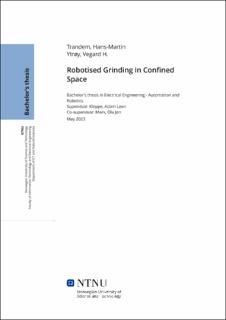| dc.contributor.advisor | Mork, Ola Jon | |
| dc.contributor.advisor | Kleppe, Adam Leon | |
| dc.contributor.author | Trandem, Hans-Martin | |
| dc.contributor.author | Ytrøy, Vegard H. | |
| dc.date.accessioned | 2023-07-06T17:23:36Z | |
| dc.date.available | 2023-07-06T17:23:36Z | |
| dc.date.issued | 2023 | |
| dc.identifier | no.ntnu:inspera:146719400:148629468 | |
| dc.identifier.uri | https://hdl.handle.net/11250/3076960 | |
| dc.description.abstract | Denne bacheloroppgåva viser funna av dei føreslegne metodane og teknikkane. Observasjonane og dataene som er generert gjennom denne avhandlinga viser potensial for betydelege forbetringar i systemets yteevne og kapabilitetar. Vidare forsking og utvikling kan gi enda betre resultat, og potensielt opne opp for nye moglegheiter for bruk av desse teknologiane. Resultata av denne studien viser at det er rom for meir arbeid på dette området, og det fremhever også viktigheita av vår studie i det større bilete.
Dette bachelorprosjektet hadde som mål å finne ei løysing for å oppnå fjernsliping inne i ein tank med gropkorrosjon. Tankens innside må slipes glatt før den kan sveisast igjen. Vi fann det svært lovande å bruke ein 6-akset robot utstyrt med ein vinkelslipetilbehør. Nokre av hovudutfordringane vi møtte inkluderte montering av roboten, unngå kollisjonar og handtering av kraft mot overflata.
Vår løysing brukar NX-programvare for design, bane programmering og simulering, samt ein tilpassa robotkontroller for overflatekraftkontroll. Vi oppdaga at bruk av NX som bane programmering og simulering programvare tilbyr ei lovande løysing. I tillegg viser vår tilpassede kraftkontroller en fire ganger forbetring i kraftkontroll sammenlignet med den innebygde kraftkontrollen på UR10e. Vi klarte ikkje å integrere banen generert fra NX med det tilpassede kraftmoment systemet. | |
| dc.description.abstract | In this bachelor thesis, the findings demonstrate the effectiveness of the proposed methods and techniques. The observations and data generated through this thesis shows potential for significant improvements in the performance and capabilities of the system. Further research and development could yield even better results, potentially opening up new opportunities for the application of these technologies. The results of this study show there is room for more work in this area, and it also highlights the importance of our study in the bigger picture.
This bachelor’s project aimed to find a solution for achieving remote grinding inside a tank with pitting corrosion. The tank’s interior needs to be ground smooth before it can be re-welded. We found it very promising to use a 6-axis robot equipped with an angle grinder attachment. Some key challenges we encountered included mounting the robot, avoiding collisions, and managing forceon the surface.
Our solution utilises NX software for design, path programming, and simulation, as well as a custom robot controller for surface force control. We discovered that using NX as a path programming and simulation software offers a promising solution. Moreover, our custom force controller demonstratesa four-fold improvement in force control compared to the built-in force control on the UR10e. Wewere not able to integrate the path generated from NX with the custom force torque system. | |
| dc.language | eng | |
| dc.publisher | NTNU | |
| dc.title | Robotised Grinding in Confined Space | |
| dc.type | Bachelor thesis | |
